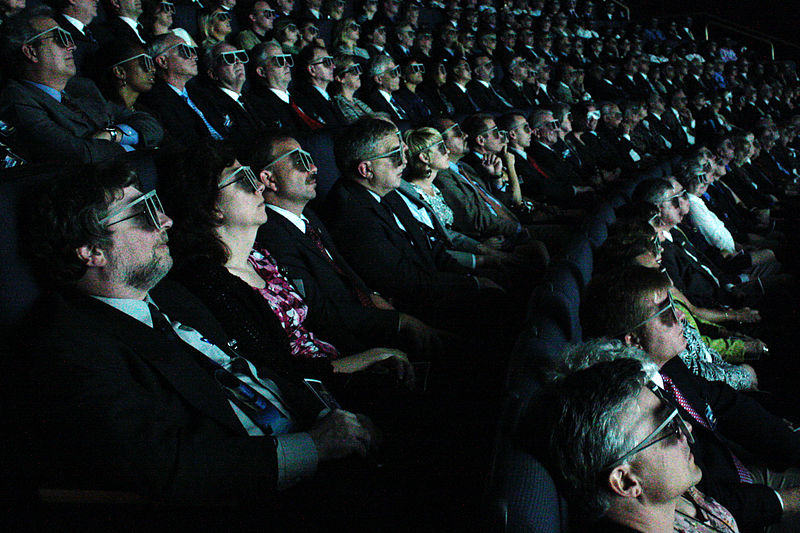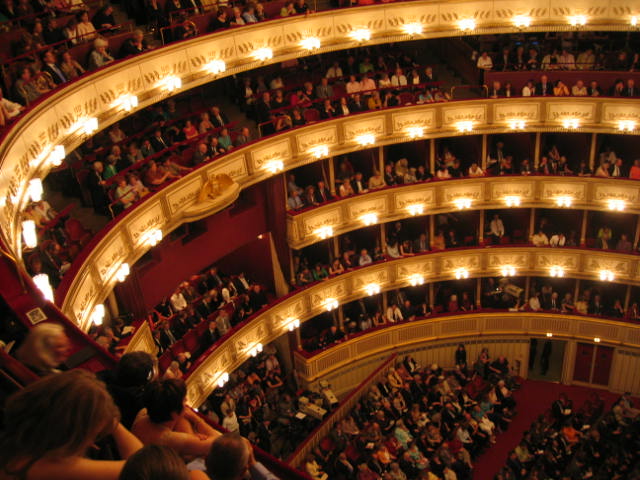Art in the Attention Economy
Emily Gastineau ponders the evolving currencies of attention in the arts, what it means to produce something for another's gaze and, conversely, the real agency and power of the viewing experience.

Attention—how to pay it, how to receive it—has long been a concern of time-based artists, but the mechanics of attention in our cultural context have been shifting rapidly. Engagement is now a primary goal in the corporate and nonprofit worlds alike. Information is abundant but attention is a commodity, a scarce and measurable resource. Products must be framed as transformational experiences instead of just things to buy. Dance, with its deep knowledge of how embodied experiences unfold over time, should have a monopoly in this new world. Engagement and experience are our terrain. We in the field are holding a grand opportunity to question what engagement means beyond clicking “like”—to complicate what it means to have an experience. Yet I find too often that dance operates on a simplistic vector, where capturing attention is good and that losing attention or creating boredom is a failure. This is, not coincidentally, the same vector that advertisers measure. As a practicing dance and performance artist, I have become curious about this unspoken value in my field, how it determines the forms performance takes and the criteria for its success and failure. This essay, the first of a series, will dig into what it means for a viewer to pay attention in 2015, how agency and power are tied up in the viewing experience, and how the attention economy is changing conventional notions of spectatorship.
As a structural principle of choreography, the question of attention is woven into the language we use to describe and evaluate work. Experimental and conventional choreographers alike repeat the dictum that “good choreography will direct the eye.” When dance artists give feedback to each other, we try to move beyond liking or disliking, but engagement and boredom often become replacement language for those same feelings. It appears in one codified example, the Red Eye Theater’s feedback protocol—on which many performance makers in the Twin Cities have cut their teeth, where my collaborator and I developed our most recent work, and for which I have great respect. In their protocol, the section of “warm feedback” asks for parts that stimulated or engaged you, while moments of disengagement belong with “cool feedback” and questions. In general written and spoken responses to performance, we say, “I was interested in…” and “I was surprised by…” to connote focus and absorption on the part of the viewer and success on the part of the choreographer. If you say, “My mind drifted…” during a particular part, it’s assumed that that section is incoherent or insufficiently developed. Surely we can imagine more capacious criteria for what a work of performance should do, or the effect it can have on the viewer.

The way we view performance is bound up in questions of power, agency, and representation. Classic feminist theory, going back to Laura Mulvey, elucidates the male gaze as an archetypal spectator and consolidation of power that beholds the body of the performer as object. The idealized spectator is not a real viewer with flesh, blood, history, and opinions, but the dynamics of the male gaze shape how real, live viewers experience and interpret performance that is presented to them. To surveil is to become omniscient, to gain a measure of control over that which is visible. The object of the gaze is correspondingly distanced, exoticized, subject to the framing and assumptions of the viewer. Choreographers can engage strategically with the male gaze, catching and warping it to control how the viewer sees the bodies presented onstage, especially to endow female, queer, racialized, and otherwise non-normative bodies with agency. Experientially, the power dynamic between performer and audience is less one-directional, yet still loaded. Some spectators (myself included) report feeling at the mercy of the performer or like an instrument of the piece, particularly when presented with an unconventional performance format or some type of participation. These two poles speak to the concomitant power and vulnerability of viewing itself: when you gaze upon the body of the performer, your ideals are exposed. This gap between archetype and experience produces a tension that is fundamental to live performance.
__________________________________________________
Engagement, interactivity and participation may have roots in the avant-garde, but they have been wholly embraced by capitalism — so artists must look on them as fraught terrain.
__________________________________________________
Recent choreographic practices in contemporary dance have often professed the goal of bestowing agency upon the viewer, or rather, emancipating the spectator. This can take myriad forms, from abstract movement that refuses clear interpretation to works where the audience is invited to wander throughout the performance space. These two common formats reveal particular assumptions about agency: the former supposes that power lies in the interpretation, while the latter presumes that power derives from physical action and the ability to change one’s literal perspective in relation to the work over time. Further down the continuum, artists concerned with audience agency often employ elements of participation, which may offer the viewer some degree of control over how the work unfolds. Yet these devices meant to bestow agency rarely allow the viewer to fundamentally change the work. Even in a “choose your own adventure” style immersive theater experience, the viewer only has the illusion of options; the available choices are determined by the artist in advance. Even if an artist asks the audience to move out of their seats for a short portion of an evening-length, proscenium performance, the requested activity does little to counteract the power relations that have already been established between performer and spectator. Sudden breaks in the fourth wall like this can also interrupt the viewer’s empathic connection with the performance.

In the modes described above, the artists’ professed commitment to audience agency is at odds with several other currents structuring the work: the knowledge that many viewers dislike being asked to participate, the desire to control the outcomes of the performance, the wish to provide a “full” experience for the audience, an attachment to standards of professionalism. Moreover, performance structures designed to make space for audience agency generally appear as representations of agency, rather than actually allowing the viewer to act independently or to make free choices. The performance environment, despite the appearance of open-endedness, remains highly structured. Moreover, when capitalism already invites consumers to interact, customize, and choose from among a variety of products—40 kinds of toothpaste, black or pinto beans at Chipotle—it doesn’t surprise me to encounter multiple options in performance. At a moment when mainstream corporations solicit conversation with consumers as a means of promotion, I don’t necessarily feel empowered when audience voices are used as source material for a work. When people have an unprecedented ability to browse, sample, and mute all manner of media and entertainment at will, I don’t necessarily find myself transported by performances that prompt me to do the same. I don’t want to completely foreclose the possibility that these techniques could grant agency to the viewer, but we can no longer assume that they are always challenging or unconventional. Engagement, interactivity and participation may have roots in the avant-garde, but they have been wholly embraced by capitalism — so artists must look on them as fraught terrain.
__________________________________________________
When every marketer is trying to simply capture your fleeting attention,
why should performing artists want to compete in the same race, by the same rules?
__________________________________________________
And yet even within conventional modes of performance, where on the surface the viewer is not asked to do more than sit and watch, there are large degrees of agency that the spectator can engage. I believe that conventional viewing is far from passive, but rather an embodied process drawing on kinesthetic empathy. The spectator can not only engage a range of qualities of attention, but also draw on a range of ways of making meaning. The particular quality of attention can be a conscious choice on the part of the viewer, but it can also take cues from the performance environment. The attentive viewer responds to how the work asks to be watched. Spectators may lean in with their focus, as if they are listening to the last lecture before an exam they must pass, actively reaching out for important information and cataloguing it in real time. Likewise, they may lean back and let the content wash over them, keeping a loose attention to specifics in favor of more generalized immersion in the sonic and visual environment of the performance. The viewer may be pulled strongly through the narrative of the work, like riding a roller coaster or watching an action movie, so that the next twist or turn is just a step ahead of the viewer’s desire for it. This last mode, appearing in mainstream entertainment as well as in avant-garde performance, serves the viewer a large amount of content while allowing their focus to be relatively passive, capitalizing on their desire for novelty and stimulation. These are just a few examples; there are many more permutations of how qualities of attention can manifest, and viewers often shift between a number of modes of attention within the course of a single performance. I’d like to see viewers to take on more responsibility, consciousness, and willingness in their role, but I don’t think that more focus is necessarily better in service of that end. All qualities of attention require a particular labor and present a particular challenge.

The state of attention with which a performance is viewed is also a crucial factor in its interpretation. When giving feedback in dance, it’s considered both polite and rigorous to describe what is seen as a matter of fact (e.g., “the performer repeated a gesture with her hands”), before diving into judgment or other subjective thoughts (e.g., “she was building a shelf”, or, “the movement was unoriginal.”) I propose that describing our state of attention throughout viewing the piece should be a necessary step in arriving at interpretation. In dance writing (or spoken responses to performance) where the state of attention is not explicitly expressed, it is often revealed by the language the viewer uses. When a response primarily describes a viewer’s experience of the landscape of the piece, I infer that that viewer used a softer focus. When I read or hear judgment calls about which sections were “weak” or “successful”, or if the response describes a particular conceptual or narrative arc substantiated with specific details from the piece, I associate that with a more intent focus. And always, I listen for language hinting at the experience of boredom, disengagement, or lack of focus—which is usually reflected back on the failure of the choreographer, rather than reflecting on the viewer or the myriad of factors that contribute to the viewer’s state of mind while watching the piece.
When every marketer is trying to simply capture your fleeting attention, why should choreographers want to compete in the same race? In a world where we are bombarded with constant, low-level bursts of frisson, the way we structure our attention to performance needs to change. Viewers are no longer looking for an antidote to their boredom, but a qualitative break in their daily overstimulation. Our collective sense of timing is shifting rapidly, requiring new temporal formats and altered timescales within each work. If we, as performance makers, understand that we are making work in the attention economy, we might do well to start from an understanding of the sense of time, novelty, overstimulation, and access to information that viewers bring into the performance space with them. Once we question our value of attention as commodity, and the need to capture attention as an immutable, underlying principle of choreography, we can then be free to develop performance forms that complicate this cultural dynamic rather than falling into an entertainment paradigm. We might find that boredom has a compelling political efficacy, or that a laser-sharp focus requires particular effort and training on the part of the audience. In future articles, I will look at work and speak with artists who are reconfiguring spectatorship with an understanding of these contemporary currents. To work from this standpoint could actually reposition the field of dance and performance within the attention economy, beyond an alternative leisure activity to a site for timely and challenging research.
Emily Gastineau is an independent artist working in and beyond the fields of dance, performance, and criticism, and Program Coordinator for Mn Artists. She collaborates with Billy Mullaney under the name Fire Drill. They work along the disciplinary boundaries of dance, theater, and performance art, conducting experiments around the notion of contemporary and how performance art is meant to be watched.